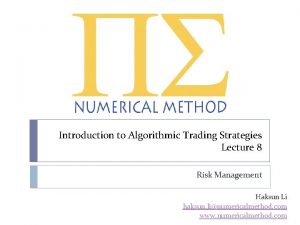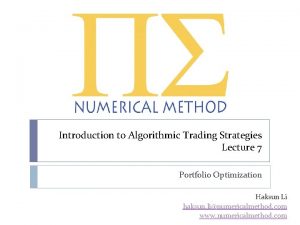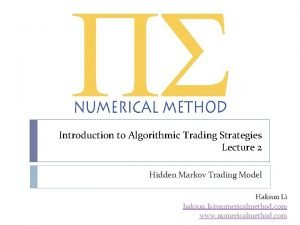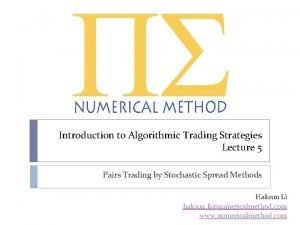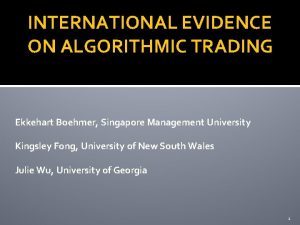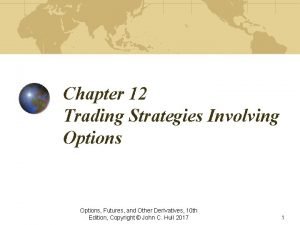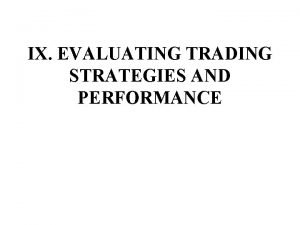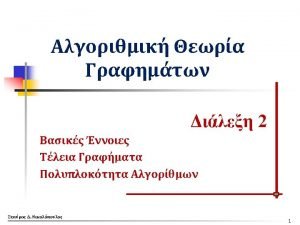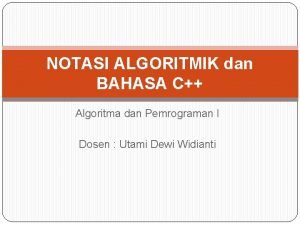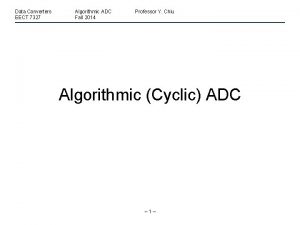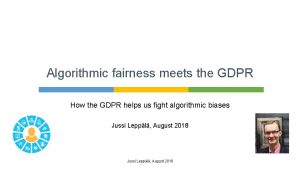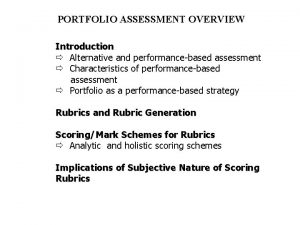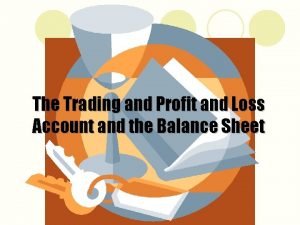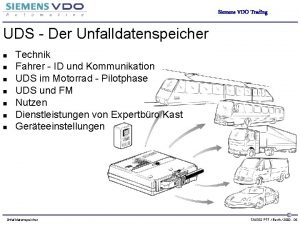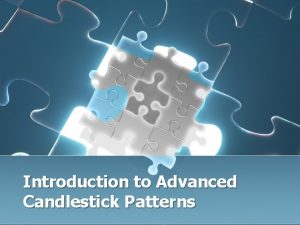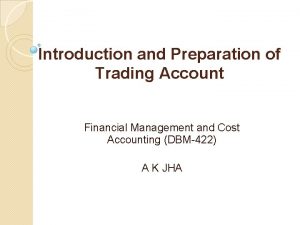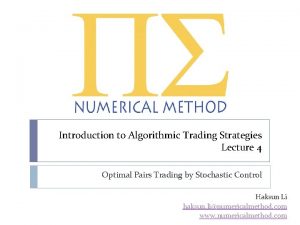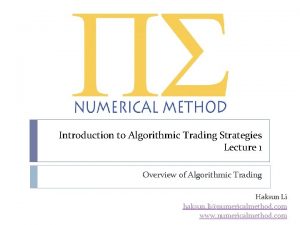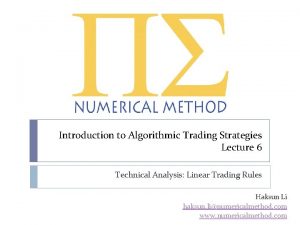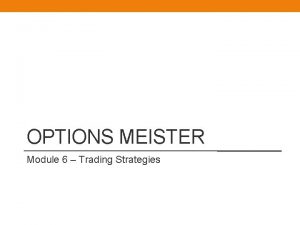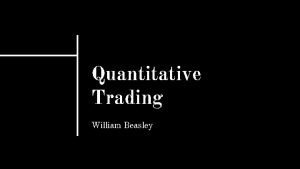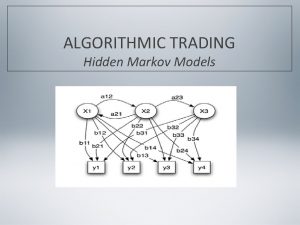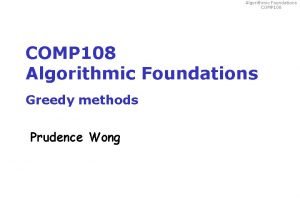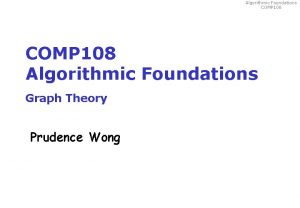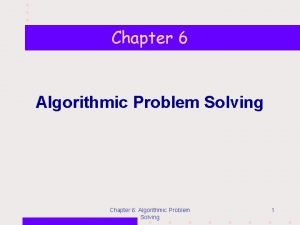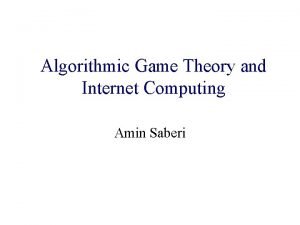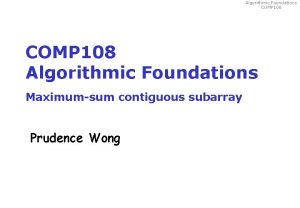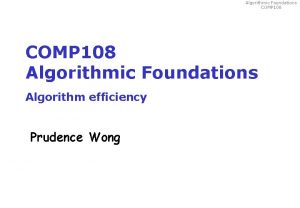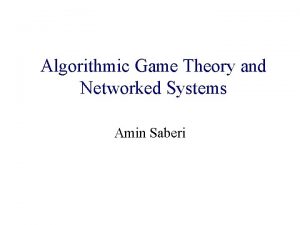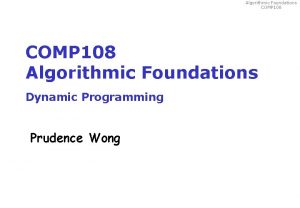Introduction to Algorithmic Trading Strategies Lecture 7 Portfolio






















































- Slides: 54

Introduction to Algorithmic Trading Strategies Lecture 7 Portfolio Optimization Haksun Li haksun. li@numericalmethod. com www. numericalmethod. com

Outline � Sharpe Ratio � Problems with Sharpe Ratio � Omega � Properties of Omega � Portfolio Optimization

References � Connor Keating, William Shadwick. A universal performance measure. Finance and Investment Conference 2002. 26 June 2002. � Connor Keating, William Shadwick. An introduction to Omega. 2002. � Kazemi, Scheeweis and Gupta. Omega as a performance measure. 2003. � S. Avouyi-Dovi, A. Morin, and D. Neto. Optimal asset allocation with Omega function. Tech. report, Banque de France, 2004. Research Paper.

Notations �

Portfolio Statistics �

Sharpe Ratio �

Sharpe Ratio Limitations � Sharpe ratio does not differentiate between winning and losing trades, essentially ignoring their likelihoods (odds). � Sharpe ratio does not consider, essentially ignoring, all higher moments of a return distribution except the first two, the mean and variance.

Sharpe’s Choice � Both A and B have the same mean. � A has a smaller variance. � Sharpe will always chooses a portfolio of the smallest variance among all those having the same mean. � Hence A is preferred to B by Sharpe.

Avoid Downsides and Upsides � Sharpe chooses the smallest variance portfolio to reduce the chance of having extreme losses. � Yet, for a Normally distributed return, the extreme gains are as likely as the extreme losses. � Ignoring the downsides will inevitably ignore the potential for upsides as well.

Potential for Gains � Suppose we rank A and B by their potential for gains, we would choose B over A. � Shall we choose the portfolio with the biggest variance then? � It is very counter intuitive.

Example 1: A or B?

Example 1: L = 3 � Suppose the loss threshold is 3. � Pictorially, we see that B has more mass to the right of 3 than that of A. � B: 43% of mass; A: 37%. � We compare the likelihood of winning to losing. � B: 0. 77; A: 0. 59. � We therefore prefer B to A.

Example 1: L = 1 � Suppose the loss threshold is 1. � A has more mass to the right of L than that of B. � We compare the likelihood of winning to losing. � A: 1. 71; B: 1. 31. � We therefore prefer A to B.

Example 2

Example 2: Winning Ratio �

Example 2: Losing Ratio �

Higher Moments Are Important � Both large gains and losses in example 2 are produced by moments of order 5 and higher. � They even shadow the effects of skew and kurtosis. � Example 2 has the same mean and variance for both distributions. � Because Sharpe Ratio ignores all moments from order 3 and bigger, it treats all these very different distributions the same.

How Many Moments Are Needed?

Distribution A � Combining 3 Normal distributions � N(-5, 0. 5) � N(0, 6. 5) � N(5, 0. 5) � Weights: � 25% � 50% � 25%

Moments of A � Same mean and variance as distribution B. � Symmetric distribution implies all odd moments (3 rd, 5 th, etc. ) are 0. � Kurtosis = 2. 65 (smaller than the 3 of Normal) � Does smaller Kurtosis imply smaller risk? � 6 th moment: 0. 2% different from Normal � 8 th moment: 24% different from Normal � 10 th moment: 55% bigger than Normal

Performance Measure Requirements � Take into account the odds of winning and losing. � Take into account the sizes of winning and losing. � Take into account of (all) the moments of a return distribution.

Loss Threshold � Clearly, the definition, hence likelihoods, of winning and losing depends on how we define loss. � Suppose L = Loss Threshold, � for return < L, we consider it a loss � for return > L, we consider it a gain

An Attempt �

First Attempt

First Attempt Inadequacy � Why F(L)? � Not using the information from the entire distribution. � hence ignoring higher moments

Another Attempt

Yet Another Attempt B C A D

Omega Definition �

Intuitions � Omega is a ratio of winning size weighted by probabilities to losing size weighted by probabilities. � Omega considers size and odds of winning and losing trades. � Omega considers all moments because the definition incorporates the whole distribution.

Omega Advantages � There is no parameter (estimation). � There is no need to estimate (higher) moments. � Work with all kinds of distributions. � Use a function (of Loss Threshold) to measure performance rather than a single number (as in Sharpe Ratio). � It is as smooth as the return distribution. � It is monotonic decreasing.

Omega Example

Affine Invariant �

Numerator Integral (1) �

Numerator Integral (2) �

Numerator Integral (3) � undiscounted call option price

Denominator Integral (1) �

Denominator Integral (2) �

Denominator Integral (3) � undiscounted put option price

Another Look at Omega �

Options Intuition �

Can We Do Better? �

Sharpe-Omega �

Sharpe-Omega and Moments � It is important to note that the numerator relates only to the first moment (the mean) of the returns distribution. � It is the denominator that take into account the variance and all the higher moments, hence the whole distribution.

Sharpe-Omega and Variance �

Portfolio Optimization � In general, a Sharpe optimized portfolio is different from an Omega optimized portfolio.

Optimizing for Omega �

Optimization Methods � Nonlinear Programming � Penalty Method � Global Optimization � Tabu search (Glover 2005) � Threshold Accepting algorithm (Avouyi-Dovi et al. ) � MCS algorithm (Huyer and Neumaier 1999) � Simulated Annealing � Genetic Algorithm � Integer Programming (Mausser et al. )

3 Assets Example �

Penalty Method �

Threshold Accepting Algorithm � It is a local search algorithm. � It explores the potential candidates around the current best solution. � It “escapes” the local minimum by allowing choosing a lower than current best solution. � This is in very sharp contrast to a hilling climbing algorithm.

Objective �

Initialization �

Thresholds �

Search �
 Introduction to algorithmic trading strategies
Introduction to algorithmic trading strategies Introduction to algorithmic trading strategies
Introduction to algorithmic trading strategies Introduction to algorithmic trading strategies
Introduction to algorithmic trading strategies Introduction to algorithmic trading strategies
Introduction to algorithmic trading strategies Algorithmic trading singapore
Algorithmic trading singapore Ireallytrade.com
Ireallytrade.com What do you mean by non trading organisation
What do you mean by non trading organisation Market microstructure trading strategies
Market microstructure trading strategies Trading strategies involving options
Trading strategies involving options Evaluating trading strategy
Evaluating trading strategy 01:640:244 lecture notes - lecture 15: plat, idah, farad
01:640:244 lecture notes - lecture 15: plat, idah, farad Asm chart for mealy machine
Asm chart for mealy machine Abstraction gcse computer science
Abstraction gcse computer science Algorithmic nuggets in content delivery
Algorithmic nuggets in content delivery Algorithmic cost modelling
Algorithmic cost modelling Algorithmic graph theory and perfect graphs
Algorithmic graph theory and perfect graphs Notasi algoritmik
Notasi algoritmik What is output in algorithm? give an example.
What is output in algorithm? give an example. Algorithmic adc
Algorithmic adc Winperl
Winperl Algorithmic state machine examples
Algorithmic state machine examples Gdpr algorithmic bias
Gdpr algorithmic bias Portfolio sample for students
Portfolio sample for students Passive bond portfolio management strategies
Passive bond portfolio management strategies Bond portfolio management project
Bond portfolio management project Active equity portfolio management strategies
Active equity portfolio management strategies Active equity portfolio management strategies
Active equity portfolio management strategies Sole trader introduction
Sole trader introduction Introduction to biochemistry lecture notes
Introduction to biochemistry lecture notes Introduction to psychology lecture
Introduction to psychology lecture Introduction to algorithms lecture notes
Introduction to algorithms lecture notes Internship portfolio introduction
Internship portfolio introduction How to write an introduction to a portfolio
How to write an introduction to a portfolio Field study 1 cover page
Field study 1 cover page Introduction for portfolio in math
Introduction for portfolio in math Esl portfolio example
Esl portfolio example What does a career portfolio look like
What does a career portfolio look like Student portfolio introduction sample
Student portfolio introduction sample Introduction for portfolio
Introduction for portfolio Example of portfolio assessment
Example of portfolio assessment Introduction in portfolio
Introduction in portfolio What is portfolio
What is portfolio Sample introduction for portfolio for english
Sample introduction for portfolio for english Introductory paragraph hook strategies
Introductory paragraph hook strategies What is a consumable store
What is a consumable store Tsl success trading sdn bhd
Tsl success trading sdn bhd Tsl success trading sdn bhd
Tsl success trading sdn bhd Profit and loss acount
Profit and loss acount Teejan contracting abu dhabi
Teejan contracting abu dhabi Alan michael sugar
Alan michael sugar Siemens vdo trading ag
Siemens vdo trading ag Ipee amiral trading impex sa
Ipee amiral trading impex sa Window dressing artinya
Window dressing artinya Scoop pattern trading
Scoop pattern trading Trading account is prepared to find out? *
Trading account is prepared to find out? *
